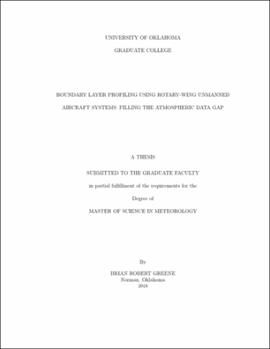| dc.description.abstract | The planetary boundary layer (PBL) is comprised of energy exchanges with the Earth’s surface, and as such plays a large factor in the evolution of weather con- ditions. However, traditional methods of observing the atmosphere, such as ra- diosondes and surface weather stations, considerably underrepresent processes oc- curring in the PBL. More recently, surface-based remote sensing capabilities have advanced, but these instruments are often expensive and difficult to implement across large scales operationally.
Using small unmanned aircraft systems (sUAS) to make atmospheric ob- servations is rapidly being realized as a means to collect previously unobtainable observations in the lowest part of Earth’s atmosphere. This study seeks to build off these advancements in technology to develop a rotary-wing sUAS (rwUAS) for collecting in-situ thermodynamic and kinematic measurements of the PBL. To do so, it is imperative to establish an understanding of the strengths and limitations of the sensors and retrieval algorithms implemented, as well as how they perform under various configurations and flight conditions. This process began with the selection of sensors capable of making high quality measurements operating stan- dalone that were also small enough to reasonably mount onboard a rwUAS. These sensors were calibrated using an environmentally controlled chamber and validated against instrumented towers and were determined to be reliable enough moving for- ward to the next stage, which was integrating them with rwUASs. Having sensors perform well in a lab setting is important, but their placement onboard a rwUAS introduces additional sources of error and uncertainty. Optimal siting locations for thermistors were examined, with results indicating that it is possible to obtain accurate measurements in the propeller wash if the sensors are adequately aspi- rated and motor, frictional, and compressional heating are avoided. In addition to thermodynamic measurements, a statistical model to estimate horizontal winds was derived by implementing Euler angles derived from the rwUAS’s autopilot. Once these measurements were optimized individually, the systems were further validated against instrumented towers, radiosondes, and other sUASs.
Capitalizing on the intricacies of collecting meaningful observations learned through this calibration and validation, the Center for Autonomous Sensing and Sampling (CASS) at the University of Oklahoma (OU) designed and built the CopterSonde, a rwUAS optimized for thermodynamic and kinematic measurements in the PBL. This specialized aircraft allowed for the exploration of scientific ob- jectives to determine the utility of rwUAS in the larger context of observational capabilities. The Environmental Profiling and Initiation of Convection (EPIC) was a field campaign in the spring of 2017 that demonstrated the capability of UASs to provide forecasters with quasi-real time profiles of pre-convective envi- ronments. Furthermore, a method of evaluating vertical heat flux profiles during diurnal PBL transitions was examined. The results presented herein represent foundational efforts towards developing the infrastructure required for successful rwUAS operations. To conclude, an outlook for tapping into the serviceability of rwUAS for atmospheric sciences is discussed. | en_US |
